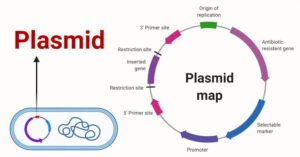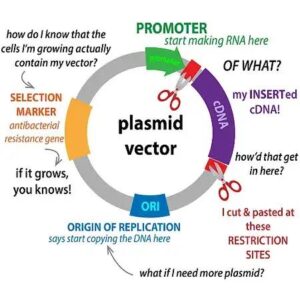Back to: MICROBIOLOGY 100 LEVEL
Welcome to class!
Hello superstar! I’m glad you’re here again—ready to learn and grow. Today, we’re diving into the world of plasmids and their roles. Even though plasmids are tiny, they play a mighty role in the survival and power of many microorganisms. If bacteria were students in school, plasmids would be like their secret exercise books—full of tips and tricks to pass tests, avoid punishment, and even win awards!
Plasmids And Their Roles
What Are Plasmids?
Plasmids are small, circular pieces of DNA found in bacteria and some other microorganisms. Unlike the main bacterial chromosome, plasmids are not essential for survival, but they often carry very helpful genes.

Think of a bacterium’s chromosome as its WAEC syllabus—it’s compulsory. A plasmid, however, is like an extra past questions booklet—it’s optional but can be very useful when things get tough!
Most plasmids can replicate independently, meaning they make copies of themselves without relying on the cell’s main DNA. A bacterium can have one or many plasmids.
Types of Plasmids and Their Roles
Plasmids come in different types, each serving different purposes. Here are some of the most common ones:
R-Plasmids (Resistance Plasmids):
These carry genes that make bacteria resistant to antibiotics. If you’ve ever heard of “drug-resistant infections,” this is often the culprit. These plasmids help bacteria survive even when antibiotics are trying to kill them.
F-Plasmids (Fertility Plasmids):
These are involved in conjugation. They allow one bacterium to form a pilus and transfer DNA to another bacterium—like sharing success secrets during an exam.
Col Plasmids:
These carry genes that help bacteria produce bacteriocins, which are proteins that can kill other competing bacteria. It’s like a market woman who not only sells the best pepper but also finds a way to chase away her competitors!
Degradative Plasmids:
They help bacteria break down unusual substances, like oil or pesticides. This makes them very useful for bioremediation—cleaning up polluted environments.
Virulence Plasmids:
These carry genes that make bacteria more dangerous or harmful, helping them cause disease more easily in plants, animals, or humans.
Why Are Plasmids Important?
Medical importance: Plasmids help us understand how infections become resistant to treatment.

Research and Biotechnology: Scientists use plasmids in genetic engineering. For example, insulin is made by inserting the human insulin gene into a plasmid, which is then placed into bacteria.
Environmental value: Some bacteria with plasmids can clean up oil spills or help in waste treatment.
Think of a student with a regular school bag (chromosome) and a mini pouch filled with sweet tips, cheat codes (not for exams o!), and useful tools (plasmid). That pouch isn’t required, but when the power goes out or the rain starts, it becomes very helpful.
Summary
- Plasmids are small, circular DNA found in bacteria.
- They carry helpful but non-essential genes.
- Different types serve different roles: antibiotic resistance, toxin production, digestion of pollutants, and more.
- Plasmids are valuable in medicine, agriculture, biotechnology, and environmental management.
Evaluation
- What is a plasmid?
- Mention three roles of plasmids in bacteria.
- What type of plasmid is responsible for antibiotic resistance?
- How are plasmids used in biotechnology?
- Explain the difference between a bacterial chromosome and a plasmid.
You just learnt something scientists and doctors use every day to fight disease and create solutions. Keep believing in yourself—your brain is powerful, your future is bright, and Afrilearn is always proud of you. Let’s keep going together!
